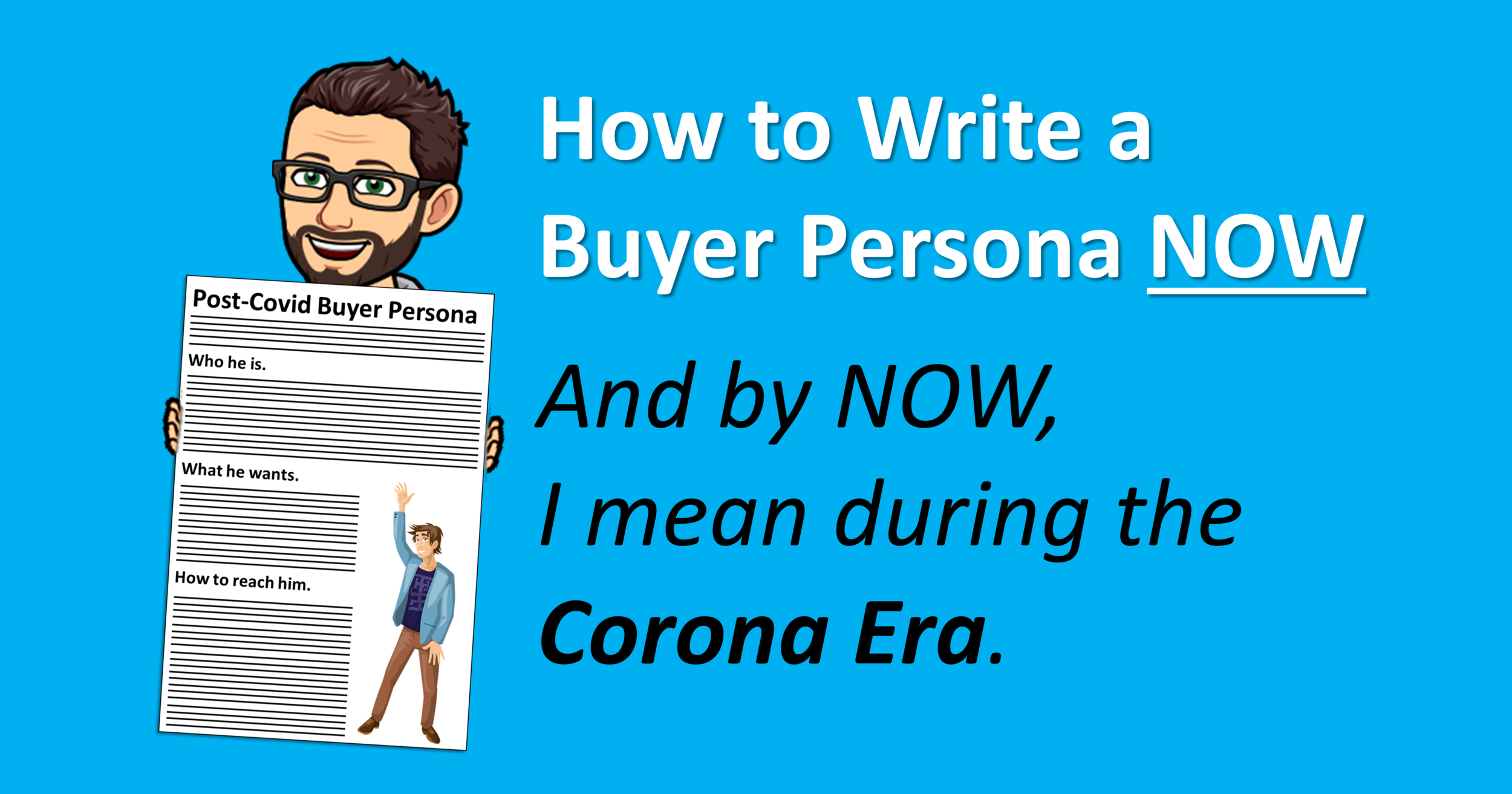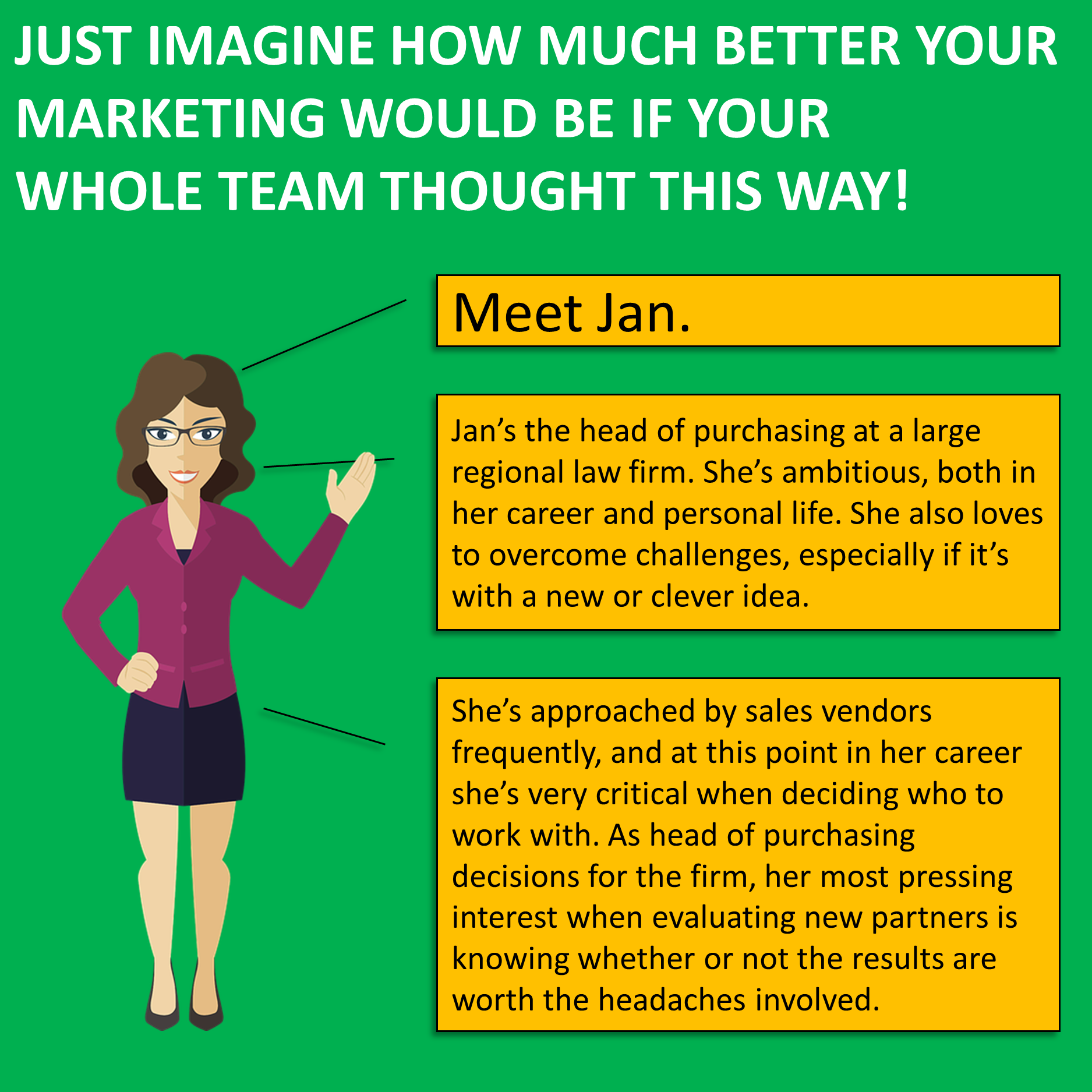I had a friend recently ask me about the buyer persona writing process, so he could put together one for his own audience. And to me, that sounded like an absolutely awesome idea for an article.
Unfortunately, we’re navigating some rough waters right now with the impacts of the Corona pandemic, and one of the major areas I’ve noticed the hit is actually in how I suggest write personas for marketing.
So I devised a solution – let’s do two articles in one! Yes, we’re in a weird time that’s changing some of my practices, but I figure there’s a lot of value in presenting both a non-Corona-related persona process, and a solution to writing personas in the here and now of 2020.
For those looking for ideas about how to do market research, feel free to skip ahead to the part of the process you’re going to need for your business, and definitely let me know if you have any questions.
What is a buyer persona anyways?
A buyer persona is the semi-fictitious story behind your audience segments. It answers questions about your customers regarding how they think and feel, all to paint a picture of who your marketing is truly trying to reach.
A great buyer persona helps you really understand who you’re talking to by creating a real narrative around the individual. If your audience is pirates, for instance, then your buyer persona is about Blackbeard. Take a moment to wrap your head around his story and his life – a single-page narrative that depicts exactly who Blackbeard really is.
And just imagine how much better your marketing, your communications, your messaging, everything will be when you are tailoring them to Blackbeard!
Except we’re not talking about Blackbeard – we’re talking about your customer instead. Maybe her name is Jan, and her story is how she discovered your product or service, associated it with her own needs, and ultimately purchased the product and became a customer for life, all while dealing with a never-ending myriad of very Jan-personal nonsense in the rest of her life. That’s the story we’re trying to achieve!
How to write a buyer persona.
So how do you write a great buyer persona? It’s really a two-step process:
Gather great information.
Create a compelling story.
If that sounds simple, that’s because it really is. But, of course, to do anything great, it’s all about the work that goes into each of those two steps.
So let’s look at Step 1 first.
Step 1. Gather great information.
If you want to write the best story about your key audience members, then you need to have the best information possible. And that means rich, informative, relevant data.
Quick example, if you want to write about Jan’s purchasing decision-making process, you need to know what that decision-making process looks like.
How does she feel about new ideas, vendors and services?
What is her main motivation behind making business purchases?
What other things might be going on in her life that would influence, detract or distract her from the decision-making process?
If you’re a B2B service provider looking to work with law firms, then knowing these things about Jan is exactly what you’re going up against. And to get there, you need to find as much information about people just like Jan – AKA purchasing decision-makers at law firms.
So, how do we find that information? Well, there’s a ton of ways, and that’s what makes the buyer persona process so much fun right now.
Here’s a few different methods you can employ right now to start gathering great information.
Industry publications.
Take a look for associations with newsletters and surveys that your audience might be a part of, and reach out to obtain information or see if it’s available online. Here’s a list of the most active industry associations and trade groups in the U.S.
Publicly available data sources.
Sites like the U.S. Census Bureau or the Bureau of Labor Statistics are excellent at learning about audience size, languages spoken, income and buying power, and more.
Talk to your customers.
This might not seem like the most cutting-edge method, but sitting down with a few members of your audience and probing their minds is a fantastic way to gather great, rich insights about who they are and how they think and feel. You can do it through phone, Zoom or more!
Note: for those wondering ‘what is an insight?’ be sure to read this article!
Conduct a survey.
If you really want to get into the nuts and bolt of how an audience ticks, a survey helps you talk to many people at once, and combine their responses into clear, informative decisions. You can use a free tool like SurveyMonkey or even Mailchimp!
My recommendation, go with a combination of the above methods. Lean on the strategies you feel strongest about, and reach out to a market research partner if you want to explore something you’re unsure of.
Don’t worry about having too much information – we’ll get to that. Gather as many great ideas, information, data, and insights as you can, and be proud of the mountain of notes and excel docs you’ve accumulated!
Now let’s dive into Step 2.
Step 2. Create a compelling story.
Think for a moment, which of the following are you more likely to be able to reach better through marketing?
Men, ages 30 to 45, with an income of $50,000 per year.
Your best friend.
If you’re like most people I speak to about marketing and market research, then you fell into the second bucket. Of course marketing to your best friend is going to be better marketing, because you know a ton about your best friend. Whereas the middle-aged middle-income men, while an obvious audience segment, is not someone you inherently connect with.
Fortunately, at this phase, you do know a ton about your audience, because we gathered some great information in our first step! Now, let’s turn that information into something useful.
Start by organizing all of your data.
In whatever fashion you think makes sense, seek out similarities in the data and findings, and put likeminded pieces together.
Do you have articles about how your audience thinks and feels? Pull them all into a single word doc.
Do you have tons of data about the audience size, income, etc.? Include it all in a single excel doc, or re-write the major findings in a written format.
Cut, condense and eliminate the redundancies.
Without question, you’re going to come across a lot of information that you aren’t going to need.
Statements and ideas that don’t pertain to marketing at all.
Repeating information that’s discussed in multiple data sources or articles.
Information that simply doesn’t need to be stated.
Go crazy with your editing skills, and start cutting out everything that’s not going to benefit you in the final buyer persona.
Regroup what’s left into the major buckets.
When it comes to buyer personas, it’s all about knowing three major things.
How does this person feel about your product or service?
What’s most important to this person? (note, we’re not just talking about your product or service here)
How can they be reached and moved?
Look at the information you have remaining, and divide it up into each of the above buckets. From here, you’ll finally be able to write your great buyer persona.
Rewrite it into a short, coherent story.
With nothing but great information left, it’s time to put on your writer’s hat and create the most compelling short-story about your audience.
Recreate facts and information as insights, creating an insights definition that details the story of how your audience engages with your business from start to finish. And spend a good amount of time truly crafting this into a well-written piece of content. Write something you’re proud of, that you want to share with your team. Consider this the ultimate playbook about who you’re trying to reach, and let the insights from your beautifully crafted piece of writing shine through and inspire!
Give your persona a name.
Naming your persona might seem trivial, but I’ll argue it’s possibly the most important part of the puzzle. Why? Because a name ultimately changes how you create your marketing for your buyer.
Take a moment and imagine your marketing team is creating a campaign, and throughout the process they’re constantly referring to the audience as “the audience”. Not very emotional, is it?
Now, imagine instead that you’re creating something incredible, some innovative piece of marketing content, and you and your team collectively ask “How will Jan think about this ad?” Pretty powerful, right? That’s because names connect it all together. They create life, bringing your market research insights together with something real and tangible.
My advice on names? Find something real. Take a look at the average age of your audience, and look back to see what the most popular baby names were for the year they were born. This will help you hone in on the most statistically-likely name of your audience members, and you’ll have a fantastic anchor to bring a real person into the mind of your marketing team.
How to use buyer personas in marketing.
Great, now you have your buyer persona. Now what?
Now, you need to let it guide your marketing.
The greatest buyer persona in the world is only worthwhile with application. That’s why you need to regroup with your marketing team, analyze and review the completed persona together, and then tackle all of your marketing to make sure it aligns with what you know about your important target audience.
Does the messaging align with what we know about Jan?
Does the media strategy fit into Jan’s lifestyle?
Are we addressing the pain points that impact whether Jan makes a purchasing decision?
Be honest and open, and take the time to really examine whether your marketing is reaching Jan in the right way. If it’s not, be open to change it!
Multiple personas for targeted results.
If you’re like most marketing organizations I’ve worked with, what you’re going to find is that you have a few distinct marketing audience segments that you need to address. So, what does that mean for the buyer persona?
It means you need to create a few personas!
If you’ve done your research and realized that you have three, four, five or more truly distinct buyer types, then you need to learn everything you can about each of those buyer types. And that means creating multiple personas, and ultimately going through the steps multiple times.
The benefit of this? More targeted marketing! Now, instead of creating broad marketing strategies that reach everyone, you create more hyper-focused marketing strategies that move specific audiences to action.
The problem with personas now.
Book Recommendation!
I read Everybody Lies last year, and it really gave some incredible insights into how we can use data to better understand our audiences! It’s a definite read if you want to map out a better buyer persona project for your marketing!
The strategy above is exactly how I conduct my buyer persona projects for my clients when they need a market research partner, and it’s exactly the strategy I normally recommend to marketers when creating their own personas.
Unfortunately, in mid-2020 right now, this is not specifically how I would recommend going about the buyer persona journey.
See, I’m normally a huge proponent of gathering existing data on an audience – public information, industry surveys, etc. – to figure out how your audience ticks. But right now, there just isn’t any existing information.
How are people going to be making purchase decisions in the near future?
What is the average income and buying power of your audience?
Does your audience even care about your product or service right now? If not, what do they care about?
The answers to these types of questions, just don’t exist for the weird intra and post-Covid world. So, what do you do?
Enter surveys.
Use surveys to create buyer personas during the Corona era.
I say this all the time, but great market research surveys help you tap into exactly how your audience thinks and feels. And right now, when we live in a time where no one really knows what’s going to happen, surveys are bringing their full strength to the marketing world.
I’ve always loved using surveys in the buyer persona process, but now they’ve become a nearly essential step, as they can help us gauge exactly what we don’t know we don’t know.
Imagine an example – you create a survey that probes into how your audience thinks about your business category, specifically addressing how your audience is thinking and feeling right now.
What is their employment status as a result of Corona?
What is their interest in buying in your category as a result of Corona?
What is most important to the audience right now? Is that different from 6 months ago?
Do they anticipate any of these factors changing in the next 3 months? 6 months? 12 months?
Now imagine you distributed this survey to a few hundred people in your email database. Or maybe you shared it on your social channels. Or maybe you partnered with a survey panel and a market research partner to reach out to larger subset of the audience.
The information you get back, using a survey designed with the above framework and distributed to the right audience, will give you exactly the information you need to develop the most cutting edge Corona-era buyer persona out there for your target market!
There’s no wrong way to eat a Reese’s, and there’s no one way to write a buyer persona.
I want to make sure to note, there’s definitely more than one way to create a buyer persona. I have some inbound marketing friends that have created a process they call the World’s Best Buyer Persona, and I’ll definitely say it’s one of the best ways of creating personas I’ve ever seen.
Hootsuite also offers a fantastic buyer persona approach and a full template, and really if you look around you’ll see dozens of different examples and methods of buyer personas out there in the wild.
My suggestion? Play around with several options until you create a persona that really feels right to you. I used to tell my students, personas almost always come across as one of the cheesier methods we marketers use, but when you put them into practice the difference in results is absolutely mind-blowing.
Take part in my buyer persona survey!
Right now I’m conducting a short survey of marketing people just like you, which you can use as an example to develop your own buyer persona survey study.
In a few weeks, I’m going analyze the data and pull together a full buyer persona for the S2 Research brand target audience, along with a step-by-step guide to show it all came together.
Not only will this be a great example, but it’ll be a fun exercise as well!
What’s next? Well, now I need your help! Click here to take part in the survey. It should take less than 5 minutes of your time, and the information will be kept confidential. The final result will be a truly kick-ass buyer persona that you can ultimately treat as an example to build out something effective for your marketing team. And be sure to sign up at the end of a survey to receive a copy of the final product!












